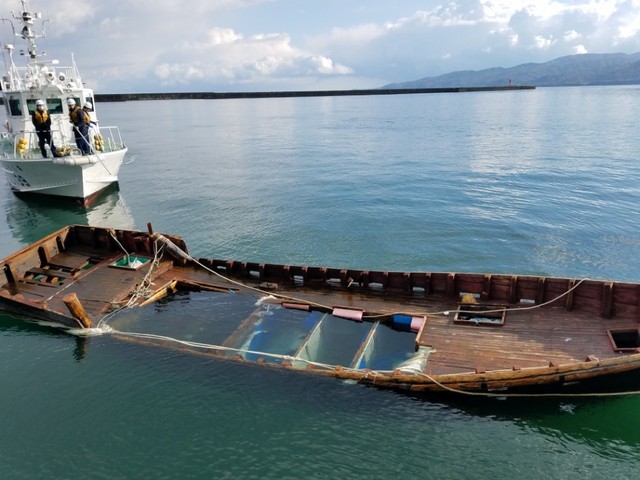 |
|
A North Korean fishing boat is towed into a Sado Island port by the Japanese Coast Guard on Dec. 7. (by Cho Ki-weon, Tokyo correspondent)
|
Japanese officials on Sado Island are reporting more rickety wooden boats washing ashore than ever before
At 10:20 on the morning of Dec. 7, a Japanese Coast Guard ship was pulling a North Korean wooden fishing boat into Ryotsu Harbor on Sado Island, in Japan’s Niigata Prefecture. The boat that came into view was old and decrepit, hardly better than a rowboat. It looked slightly bigger than the boats used by hobby fisherman. It was hard to believe that such a ship was used for commercial fishing in the middle of the ocean.
The 12 meter long fishing boat had been found around half past six that morning, tangled up in fishing nets. The prow of the boat said, “August and September are the months for preventing boating accidents.” Below that was written, “Korean People’s Army Unit ×××, Boat Number 594-56843, Cho Cheon-il, manager.” The boat presumably belonged to a fishing organization affiliated with the North Korean military. The ship contained fishing rods apparently used for catching squid, life jackets, netting, badges containing the pictures of Kim Il-sung and Kim Jong-il – and human remains.
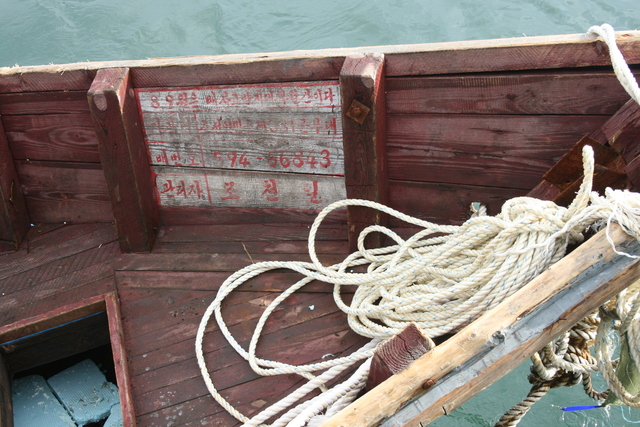 |
|
Korean script identifying a wooden boat discovered by the Japanese Coast Guard on Dec. 7 as property of the North Korean Army. (by Cho Ki-weon, Tokyo correspondent)
|
“This kind of boat probably couldn’t handle waves higher than three meters, and I doubt it could get more than five miles away from shore. It looks like they were under a lot of pressure from Pyongyang to bring in a big catch,” said Seiichi Ichihashi, a 70-year-old fisherman, as he looked at the boat.
On Dec. 7 alone, five ships that appear to have set out from North Korea were found on Sado Island. Altogether, 17 wooden ships or fragments of ships and five corpses have turned up there this year (through Dec. 9). “Every year, four or five ships that appear to be North Korean are found, occasionally with a corpse inside. But we’ve never seen as many as we have this winter,” said Osamu Ito, who is in charge of disaster prevention on Sado Island.
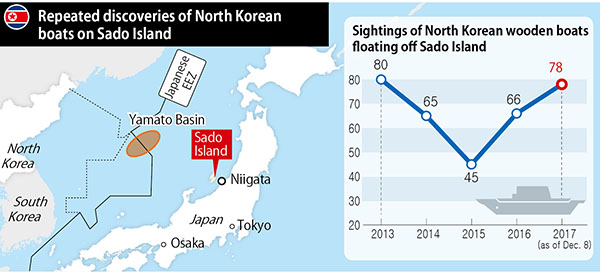 |
|
Repeated discoveries of North Korean boats on Sado Island
|
At Ettsumi, an hour’s drive south of Ryotsu Harbor, a wooden craft presumed to be a North Korean fishing boat had been driven onto the shore and beached upside down. It could not be towed away, so it had to be taken apart and removed in pieces. After investigators examined it, the North Korean boat would be stored for a certain amount of time and then classified as trash and incinerated.
Two bodies, presumably of North Korean sailors, were discovered near the boat. “The bodies were already significantly decomposed,” said Ito, who claimed to have seen them himself. While Japan repatriated the bodies of North Korean sailors in 2012, this has not happened much in recent years because of the difficulty of identifying the bodies, the fact that Japan does not have diplomatic relations with the North, and the lack of enthusiasm in Pyongyang. On Sado Island, after the bodies are cremated, they are kept for several years at a temple and then finally sent to a municipal cemetery for those who died without any relations.
“That boat is the kind that ought to have stayed within sight of the shore. Summer is challenging enough, but in the winter, when the winds pick up, it’s really reckless to go fishing in a boat like that,” said Yasuo Tanaka, 73, a fisherman in Ettsumi who reported the overturned fishing boat. “I’ve heard on the news that North Koreans were doing this because of the food shortage, but this isn’t pleasant for us, either. I hope some kind of solution is found.”
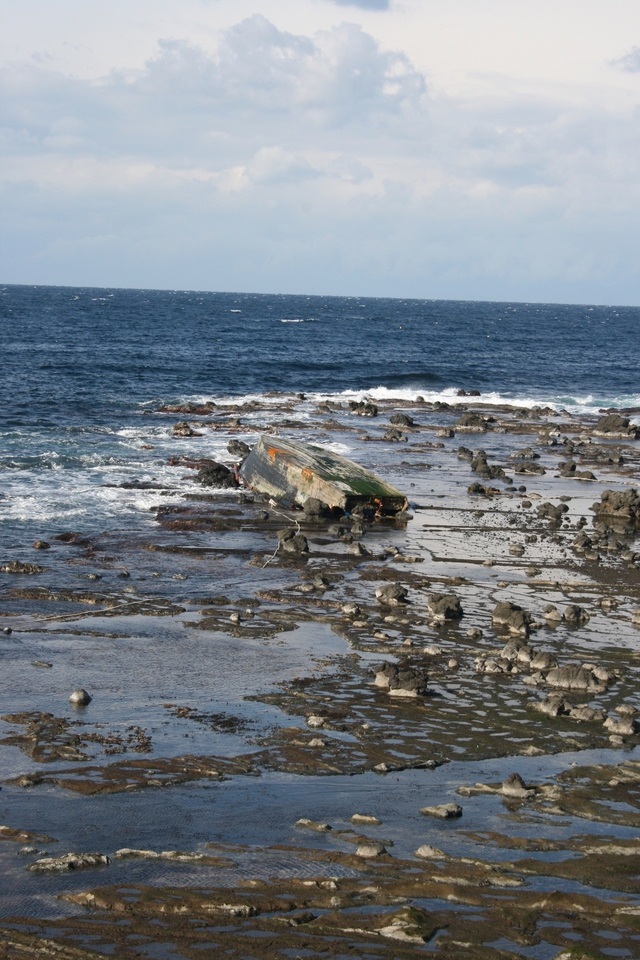 |
|
At Ettsumi, an hour’s drive south of Ryotsu Harbor, a wooden craft presumed to be a North Korean fishing boat is beached upside down on Dec. 7. Two bodies, presumably of North Korean sailors, were discovered near the boat. (by Cho Ki-weon, Tokyo correspondent)
|
“Even ten years ago, we found five or six bodies of North Koreans. The decomposing bodies smelled so bad we couldn’t get close,” Tanaka said.
In the winter, it is common for North Korean wooden boats to be driven by the northwest winds to the west coast of Japan. Since 2013, when statistics began to be kept, between 40 and 80 ships have been found each year. But 28 ships turned up this November, the most ever found in a single month. Since a total of 78 ships have been found so far this year (through Dec. 8), the Japan Coast Guard believes that the final tally for the year will set a new record. Over 60 bodies presumed to be North Korean sailors have been found as well.
The reason for the sharp increase in the number of North Korean boats found on the coast of Japan, some analysts say, is that the North Korean authorities are pressuring fishermen to increase their catch. North Korean leader Kim Jong-un said in his New Year’s address this year that “there must be a revolutionary development of the fishing industry to achieve even greater progress in improving people’s lives.”
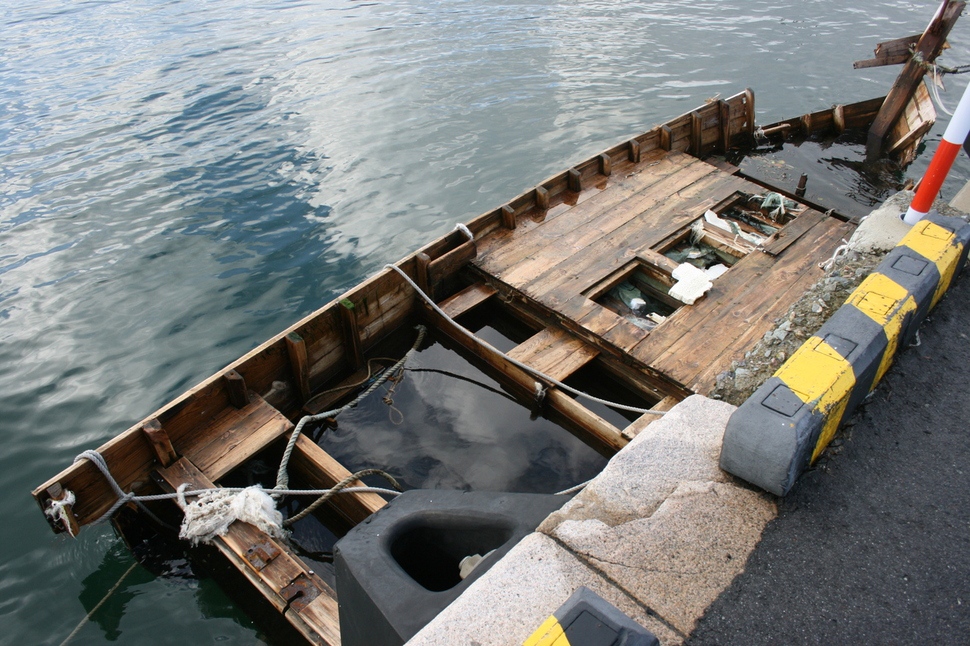 |
|
A north Korean wooden boat at Ryotsu Harbor, which was discovered by the Japanese Coast Guard on Dec. 1.
|
The Rodong Sinmun, the official organ of the North Korean Worker’s Party (KWP), echoed this appeal in an editorial last month: “Fishing during the winter is an important struggle that is of key significance in fisheries’ yearly production.” Another point is that North Korean fishermen have no choice but to go out to sea since the North sold its coastal fishing rights to China. These boats appear to be drifting to Japan after being wrecked in the rich fishing grounds at the Yamato Basin. Squid fishing gear was found on all the wrecks discovered on Sado Island this year.
The North Korean military is also thought to be giving its units fishing quotas. North Korean fishermen who were found adrift near Hokkaido last month testified that they were part of a fishing organization created by the North Korean People’s Army and that they were fishing to meet a quota, NHK reported.
While the Sado Island residents have become fairly accustomed to news about drifting fishing boats, they were still noticeably anxious. “This is where Hitomi Soga was abducted by North Korea. It’s a place where even now crab fishermen occasionally see North Korean ships,” said a middle-aged man who works at a hotel with onsen (hot springs) baths.
When I met Ichihashi at Ryotsu Harbor, he voiced his suspicions about another wooden boat, this one just 8 meters long, on one side of the harbor. “That little boat is too narrow for fishing and would normally be used for harvesting horned turban shells. I heard that, in the past, small and nimble ships of that kind were used for special operations,” he said. Sado Island informed residents where the boat was found and advised them to avoid the area.
On the afternoon of Dec. 7, clouds gathered over Sado Island. “The weather report says it’s supposed to start snowing tomorrow. That means the northwest wind will be blowing, and I bet they’re going to keep finding more wooden boats,” Ito said fearfully. The next day, one body that appeared to be a North Korean sailor was found on the island, along with another body and a wooden boat on Dec. 9.
In related news, a North Korean ship captain and two crew members were arrested by the Japanese police in Hokkaido on Dec. 9 on charges of stealing various items, including the engine of a generator, from an emergency shelter on an abandoned island. The three were among a group of 10 who were rescued by the police aboard a wooden boat adrift in the waters to the south of Hokkaido on Nov. 29. Later, allegations were raised that they had stolen a rice cooker and other items from an emergency shelter used by fishermen in the area.
By Cho Ki-weon, Tokyo correspondent
Please direct questions or comments to [english@hani.co.kr]













